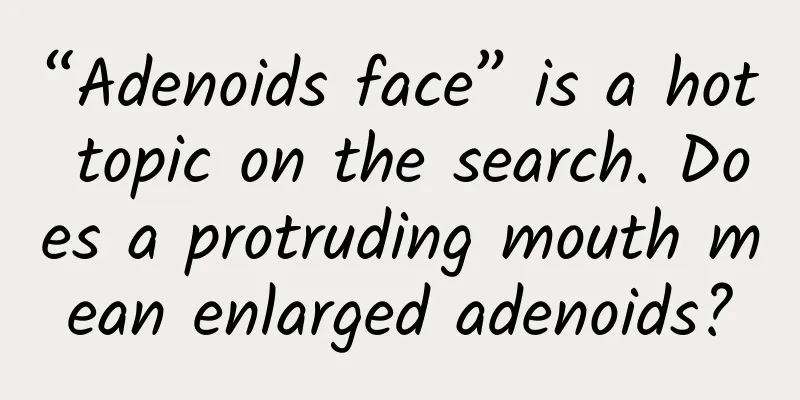“Adenoids face” is a hot topic on the search. Does a protruding mouth mean enlarged adenoids?

|
Compiled by Lv Bingxin New Media Editor: Wang Shan Recently, Huo Siyan posted a video of her son, Huheng, on her personal social account, which attracted the attention and heated discussion of netizens. It can be seen from the video that Huheng has grown up a lot. Some netizens found that Huheng's teeth are a bit protruding, and suggested that Huo Siyan take Huheng to get his teeth corrected to avoid affecting his appearance when he grows up. Some netizens also said that Huheng may have adenoid facies, which is a facial appearance caused by the enlargement of the adenoids leading to the development of facial bones. Huo Siyan then replied to the netizens in the comment area: "The doctor said no." In this regard, the netizens who were worried about him expressed their relief. (Photo source: Screenshot of Huo Siyan's Douyin video) In fact, in the past two years, "adenoids face" has witnessed parents' parenting anxiety again and again on online social platforms. What are adenoids? What is adenoids face? Should surgery be performed for enlarged adenoids? Adenoids and adenoid facies Adenoids, also called pharyngeal tonsils, are located at the top of the nasopharynx and the posterior pharyngeal wall. They belong to lymphatic tissue and have an orange-shaped surface. Like tonsils, adenoids gradually grow larger with age after birth. They proliferate most between 2 and 6 years old, reach their maximum size at 8 years old, and gradually shrink after 11 years old. In adults, adenoids are basically shrunk and no traces can be seen. Therefore, adenoids are a necessary step for every child's growth. (Photo source: "Peking University Third Hospital" WeChat official account) But enlarged adenoids are not good! Adenoids can become pathologically enlarged due to repeated stimulation of inflammation, which is called adenoid hypertrophy. Adenoid facies are mostly caused by enlarged adenoids. Sleep apnea causes long-term mouth breathing, which in turn causes facial development disorders. Common adenoid facial features seen in ENT are: ① The palpebral fissure becomes smaller; ② The distance between the eyes becomes wider; ③ The nose wings are turned outward; ④ The nasolabial groove becomes shallower; ⑤ The lips become thicker; ⑥ The upper lip becomes shorter; ⑦ The teeth are uneven and protruding forward. (Photo source: Screenshot of video from @CCTV.com Weibo) Which symptoms require prompt medical attention? Affects breathing The adenoids are located at the junction of the rear end of the nasal cavity and the throat. Enlarged adenoids can narrow the airway, thereby affecting ventilation and causing symptoms such as mouth breathing, blockage nasal sounds, and snoring during sleep. Ventilation disorders will affect children's blood oxygen supply at night, resulting in symptoms such as delayed height development, decreased intelligence, and inattention. Long-term mouth breathing can lead to "adenoid facies", which causes developmental disorders of the facial bones, elongated jaws, high-arched palate, uneven teeth, protruding upper incisors, thick lips, and lack of expression, turning the face into an "ugly duckling". Rhinitis, sinusitis Adenoids hypertrophy will release more inflammatory mediators, induce edema of the nasal mucosa, cause long-term runny nose and even induce sinusitis. Children with long-term runny nose may suffer from allergic rhinitis, with symptoms such as continuous sneezing and itchy nose. The large amount of secretions produced by rhinitis and sinusitis will further stimulate the proliferation and hypertrophy of adenoids, forming a vicious circle. Otitis media The opening of the Eustachian tube, the ventilation tube of the middle ear, is located in the nasopharynx. Hypertrophic adenoid tissue will squeeze the opening of the Eustachian tube, causing obstruction of the Eustachian tube and affecting the ventilation function of the middle ear, thus forming secretory otitis media, which is difficult to heal. When the upper respiratory tract is infected, the inflammation will reach the middle ear through the Eustachian tube, causing acute otitis media, resulting in severe ear pain and, in severe cases, ear perforation, pus discharge, and hearing loss. Persistent cough Some children with enlarged adenoids may have long-term cough. There are two causes of their cough. One is "upper airway cough syndrome", that is, the secretions from the nasal cavity and nasopharynx flow backwards, irritating the throat and trachea, resulting in long-term chronic cough. In some children, even purulent mucus attached to the posterior wall of the pharynx can be seen when they open their mouths. Another type of chronic cough is that inflammatory mediators in the upper respiratory tract stimulate the body for a long time, causing the airway to be in a sensitive state for a long time, that is, "airway hyperresponsiveness", resulting in irritating dry cough. In severe cases, wheezing or even asthma attacks may occur. Pay attention to correcting children's "mouth breathing" If you breathe through your mouth due to enlarged adenoids, enlarged tonsils, or allergic rhinitis, it is recommended that you go to the hospital to cure these diseases first. If it is not a pathological factor but just a habit, then you need to pay more attention to it in the future. Breathing through your mouth will really make you ugly. Even the best genes can be ruined by this! Because when you breathe through your nose, the air flows from nose to nasopharynx to oropharynx to throat and then to lungs; while when you breathe through your mouth, the air flows from mouth to oropharynx to throat and then to lungs. (Photo source: "Shenzhen Health Commission" WeChat official account) This gas flow that does not pass through the nasal cavity will have a series of effects on the oral cavity, tongue, teeth, mouth, upper and lower jaws, etc., such as short, thick and everted lips, buck teeth, etc. In addition, when breathing through the mouth, since the air goes directly into the lungs without being filtered through the nasal cavity, it is very easy to cause oral diseases (dental caries, periodontal disease) and respiratory diseases (sinusitis, tracheitis, frequent colds, etc.). Especially for children, it may affect their normal physical development, causing problems such as inattention in class, fatigue, and excessive movements. Therefore, once you find that you or your child has this habit, you must correct it immediately. During the day, always remind yourself to "shut your mouth" and breathe through your nose. When you go to bed at night, you can learn from what this mother does - cover your mouth with tape. (Pictures from the Internet) If facial deformity has already occurred, orthodontic treatment is recommended, which can have a certain corrective effect on the face. For children, parents have to worry more. In addition to verbal reminders, you can also try these methods: ✎Mask Law Have your child wear a mask that covers only the lips and leaves the nostrils exposed. ✎Wearing braces When worn, it seals the lips and forces the child to breathe through the nose. ✎Train your child to keep his mouth shut and breathe frequently For example, you can restore the function of the tongue muscles, perioral muscles and chewing muscles by whistling, blowing a trumpet, chewing gum and blowing bubbles. (See watermark for image source) Does enlarged adenoids require surgery? Nowadays, many people have "appearance anxiety". After learning about adenoids on the Internet, they pay special attention to adenoids hypertrophy, take the initiative to take their children to the hospital for consultation, and even take the initiative to ask for adenoids removal. It is a good thing that everyone pays attention to adenoids, but it is unnecessary to directly remove adenoids from children. There are two main factors in determining whether surgery is necessary: 1. Adenoids hypertrophy affects breathing, and children experience symptoms of hypoxia, such as snoring during sleep, physical or intellectual retardation, and adenoid facies. 2. Recurrent upper respiratory tract infections, such as long-term runny nose, fever, cough, etc. If any of the above two points occur, there is an indication for surgery. (Check your symptoms quickly...) (Photo source: "Peking University Third Hospital" WeChat official account) If surgery is really necessary, parents will start to worry: Are adenoids surgery risky? Adenoidectomy is now a very mature surgery. Doctors now mostly use endoscopes and low-temperature plasma radio frequency to perform precise removal. It will not cause damage to the face and there is almost no bleeding. The operation is very fast, and it takes about 20 minutes from the beginning of the removal to the completion of bleeding. Postoperative care is not difficult either. Many parents worry that the anesthetics used in surgery will make their children stupid, but occasional anesthesia is not harmful. Current clinical observations show that for children over 3 years old, the effect of anesthesia on brain development is limited; for children under 3 years old, anesthesia for more than 3 hours may have an impact on the brain, or the impact may be minor, which still needs further clinical observation. Adenoid surgery takes a short time and will not cause any harm to the child. If the child is not treated in time due to fear of anesthesia, long-term pathological adenoid hypertrophy will cause greater harm to the brain. (Source: CCTV.com, Peking University Third Hospital, Shenzhen Health Commission, Dingxiangmama, Yangcheng Evening News, etc.) |
>>: Webb telescope discovers mysterious galaxies that shouldn't exist
Recommend
Why do some people sleep with their eyes half open? Doctor: It may be due to these diseases
Expert of this article: Xu Qibin, associate chief...
Summary of the top 10 live broadcasting techniques, interactive techniques in live broadcasting are not boring
I don’t know what to say, I don’t know how to say...
There are four plants that grow in the desert and have strong vitality. How many do you know?
Everyone knows that in some desert areas, the tem...
This is the most comprehensive guide to all modules of product promotion and operation that I have ever seen!
When it comes to operations , everyone's firs...
Private cars are cleaned up and turned into express cars: paving the way for Didi Kuaidi's listing
On May 7, Didi launched the Didi Express project ...
Foxconn is cost-sensitive. How does the United States attract it to invest in building factories?
On July 26, Foxconn Technology Group Chairman Ter...
After updating to iOS 14.2, my phone can now translate foreign websites overnight
Have you paid attention to the latest update of S...
How important is it to hold on to "Chinese seeds" to our country's food security?
Seeds are the "chips" of agriculture, a...
Soul product operation report
Soul was launched in 2016 and quickly captured th...
4 steps to complete Baidu information flow delivery! Home decoration case sharing~
The home improvement industry is a typical large ...
Aion V is here, with a range of 600 kilometers and a price of only 170,000 yuan. After the big manufacturers wake up, how can Tesla not panic?
Under the dual influence of the epidemic and decl...
Harmful substances appear! Many people in Japan have excessive levels of organic fluorine compounds!
Audit expert: Gan Qiang Lecturer at Beijing Insti...
This is definitely the dumbest loophole in history
The college entrance examination scores of various...
How much does it cost to be an agent of Wuxi Home Improvement Mini Program? What is the price of being an agent for Wuxi home improvement mini program?
Why should you be an agent for WeChat Mini Progra...
Google poached Apple engineers to build its own chips to enhance AI and AR
June 19 news According to foreign media reports, ...









